- Page 1: WHO monographs on selected medicina
- Page 4 and 5: WHO Library Cataloguing-in-Publicat
- Page 6 and 7: Contents Fructus Schisandrae 296 Ra
- Page 9 and 10: Introduction Increasing role of the
- Page 11: nexes. Annex 2 lists the monographs
- Page 14 and 15: General technical notices medicinal
- Page 17 and 18: Fructus Ammi Majoris Defi nition Fr
- Page 19 and 20: Powdered plant material Yellowish-b
- Page 21 and 22: Fructus Ammi Majoris Uses described
- Page 23 and 24: Fructus Ammi Majoris itching, redne
- Page 25 and 26: Fructus Ammi Majoris Adverse reacti
- Page 27 and 28: Fructus Ammi Majoris Other precauti
- Page 29 and 30: Fructus Ammi Majoris 29. Lacy C et
- Page 31 and 32: Fructus Ammi Visnagae Defi nition F
- Page 33 and 34: Foreign organic matter Not more tha
- Page 35 and 36: Fructus Ammi Visnagae (20). A 95% e
- Page 37 and 38: the activities of liver transaminas
- Page 39 and 40: Fructus Ammi Visnagae 10. Quality c
- Page 41 and 42: Fructus Anethi Defi nition Fructus
- Page 43: Total ash Not more than 11.0% (1).
- Page 47 and 48: Fructus Anethi 3. Issa A. Dictionna
- Page 49 and 50: Fructus Anethi 37. GRAS status of f
- Page 51 and 52: mouse-shaped cremocarp with a small
- Page 53 and 54: Aetheroleum Anisi sporium herbarum,
- Page 55 and 56: Aetheroleum Anisi cantly increased
- Page 57 and 58: however, this effect is not mediate
- Page 59 and 60: Aetheroleum Anisi 24. Elisabetsky E
- Page 61 and 62: Fructus Anisi Defi nition Fructus A
- Page 63 and 64: Powdered plant material Grey, green
- Page 65 and 66: Fructus Anisi induced sleeping time
- Page 67 and 68: drug-metabolizing enzymes were asse
- Page 69 and 70: Fructus Anisi References 1. Egyptia
- Page 71 and 72: Fructus Anisi 36. Rompelberg CJ, Ve
- Page 73 and 74: Plant material of interest: dried r
- Page 75 and 76: Semen Armeniacae Pharmacology Exper
- Page 77 and 78: Clinical pharmacology Semen Armenia
- Page 79 and 80: Semen Armeniacae node metastasis, e
- Page 81 and 82: Paediatric use See Contraindication
- Page 83 and 84: Semen Armeniacae toxicological stud
- Page 85 and 86: Flos Arnicae Defi nition Flos Arnic
- Page 87 and 88: heads; twinned covering trichomes u
- Page 89 and 90: Flos Arnicae haematomas and petechi
- Page 91 and 92: Flos Arnicae Adverse reactions Nume
- Page 93 and 94: Flos Arnicae 4. Hänsel R et al., e
- Page 95 and 96:
Flos Arnicae 37. Hausen BM. The sen
- Page 97 and 98:
Description A straight-boled decidu
- Page 99 and 100:
Folium Azadirachti Other purity tes
- Page 101 and 102:
Folium Azadirachti aspartate aminot
- Page 103 and 104:
Folium Azadirachti 150 beats per mi
- Page 105 and 106:
Warnings No information available.
- Page 107 and 108:
Folium Azadirachti terpenoids and t
- Page 109 and 110:
Folium Azadirachti 46. Koley KM, La
- Page 111 and 112:
nately arranged, pinnately compound
- Page 113 and 114:
Oleum Azadirachti and number of emb
- Page 115 and 116:
Oleum Azadirachti Estrogenic activi
- Page 117 and 118:
However, correlation of the adverse
- Page 119 and 120:
Oleum Azadirachti 13. Ali MH et al.
- Page 121 and 122:
Oleum Azadirachti 46. Chinnasamy N
- Page 123 and 124:
hermaphrodite, usually orange-yello
- Page 125 and 126:
carthamin HO Glc HO HO * O Glc HO O
- Page 127 and 128:
Flos Carthami Cardiovascular effect
- Page 129 and 130:
Contraindications Owing to its trad
- Page 131 and 132:
Flos Carthami 6. Farnsworth NR, Bun
- Page 133 and 134:
Flos Carthami 39. Shin KH, Woo WS.
- Page 135 and 136:
Plant material of interest: dried s
- Page 137 and 138:
R2O H 3 C O CH 3 O OR2 CH 3 CH 3 H
- Page 139 and 140:
Stigma Croci tated the recovery of
- Page 141 and 142:
Paediatric use See Contraindication
- Page 143 and 144:
Stigma Croci 28. Tarantilis PA et a
- Page 145 and 146:
Geographical distribution Indigenou
- Page 147 and 148:
Pesticide residues The recommended
- Page 149 and 150:
Fructus Foeniculi Antispasmodic act
- Page 151 and 152:
Sedative effects Intragastric admin
- Page 153 and 154:
Fructus Foeniculi Paediatric use No
- Page 155 and 156:
Fructus Foeniculi 31. Sharma SK, Si
- Page 157 and 158:
Fructus Foeniculi 64. Howes AJ, Cha
- Page 159 and 160:
Radix Gentianae Luteae kled, and mo
- Page 161 and 162:
Radix Gentianae Luteae erial. Other
- Page 163 and 164:
stimulated the secretion of gastric
- Page 165 and 166:
Radix Gentianae Luteae References 1
- Page 167 and 168:
Radix Gentianae Luteae 33. Kazakov
- Page 169 and 170:
Organoleptic properties Odour: char
- Page 171 and 172:
Medicinal uses Uses supported by cl
- Page 173 and 174:
Toxicology The oral median lethal d
- Page 175 and 176:
Radix Gentianae Scabrae 10. Ohwi, J
- Page 177 and 178:
Gummi Gugguli Defi nition Gummi Gug
- Page 179 and 180:
Moisture Not more than 14% (18). Gu
- Page 181 and 182:
Gummi Gugguli diet, intragastric ad
- Page 183 and 184:
Gummi Gugguli gulsterones per 100.0
- Page 185 and 186:
phototoxic (1). However, applicatio
- Page 187 and 188:
Gummi Gugguli 15. Bruneton J. Pharm
- Page 189 and 190:
Gummi Gugguli 46. Panda S, Kar A. G
- Page 191 and 192:
greyish-brown to dark brown. Darker
- Page 193 and 194:
H HO HO OH CH3 H O harpagide H O Gl
- Page 195 and 196:
Radix Harpagophyti cardiac arrhythm
- Page 197 and 198:
Arhus low back pain index was obser
- Page 199 and 200:
Radix Harpagophyti directly through
- Page 201 and 202:
Radix Harpagophyti 36. Recio M et a
- Page 203 and 204:
and lateral surfaces, arise many lo
- Page 205 and 206:
Chemical assays Contains not less t
- Page 207 and 208:
tion of 10.0 mg/kg body weight (bw)
- Page 209 and 210:
Rhizoma Hydrastis Posology (Unless
- Page 211 and 212:
Rhizoma Hydrastis 30. Marinova EK e
- Page 213 and 214:
axils; corolla infundibuliform. Fru
- Page 215 and 216:
Radix Ipecacuanhae Pesticide residu
- Page 217 and 218:
Radix Ipecacuanhae barium sulfate (
- Page 219 and 220:
Radix Ipecacuanhae ceived activated
- Page 221 and 222:
Radix Ipecacuanhae (20). Mucosal er
- Page 223 and 224:
Radix Ipecacuanhae Other precaution
- Page 225 and 226:
Radix Ipecacuanhae 28. Curtis RA, B
- Page 227 and 228:
Aetheroleum Lavandulae Defi nition
- Page 229 and 230:
Pesticide residues The recommended
- Page 231 and 232:
Aetheroleum Lavandulae thromboxane
- Page 233 and 234:
Contraindications Aetheroleum Lavan
- Page 235 and 236:
Aetheroleum Lavandulae 19. Dunn C,
- Page 237 and 238:
Flos Lavandulae Defi nition Flos La
- Page 239 and 240:
adiating from the poles. Leaf fragm
- Page 241 and 242:
(17). A methanol extract of the fl
- Page 243 and 244:
Flos Lavandulae directly through th
- Page 245 and 246:
Strobilus Lupuli yellowish-green to
- Page 247 and 248:
Other purity tests Chemical and sul
- Page 249 and 250:
Strobilus Lupuli Antioxidant activi
- Page 251 and 252:
Contraindications Strobilus Lupuli
- Page 253 and 254:
Strobilus Lupuli 19. Langezaal CR,
- Page 255 and 256:
Gummi Myrrha Defi nition Gummi Myrr
- Page 257 and 258:
Moisture Not more than 15.0% (4). P
- Page 259 and 260:
Gummi Myrrha Antihyperglycaemic act
- Page 261 and 262:
the ability of the resin to reduce
- Page 263 and 264:
Gummi Myrrha 14. Quality control me
- Page 265 and 266:
Herba Passifl orae Defi nition Herb
- Page 267 and 268:
Powdered plant material Light green
- Page 269 and 270:
O R 6 R 8 OH Uses described in phar
- Page 271 and 272:
Herba Passifl orae to increase acti
- Page 273 and 274:
Herba Passifl orae No information a
- Page 275 and 276:
Herba Passifl orae 27. Medina JH et
- Page 277 and 278:
Plant material of interest: dried s
- Page 279 and 280:
Testa Plantaginis Medicinal uses Us
- Page 281 and 282:
Testa Plantaginis a 70% methanol ex
- Page 283 and 284:
Testa Plantaginis A randomized cont
- Page 285 and 286:
Testa Plantaginis Contraindications
- Page 287 and 288:
Testa Plantaginis 4. Issa A. Dictio
- Page 289 and 290:
Testa Plantaginis 38. Vergara-Jimen
- Page 291 and 292:
Radix Rehmanniae Defi nition Radix
- Page 293 and 294:
Total ash Not more than 6% (1, 2, 4
- Page 295 and 296:
Radix Rehmanniae Pharmacology Exper
- Page 297 and 298:
Radix Rehmanniae and late-different
- Page 299 and 300:
Precautions Carcinogenesis, mutagen
- Page 301 and 302:
Radix Rehmanniae 16. Chen LZ et al.
- Page 303 and 304:
Radix Rehmanniae 47. Matsuda H et a
- Page 305 and 306:
Fructus Schisandrae sexual, dioecio
- Page 307 and 308:
Chemical assays Contains not less t
- Page 309 and 310:
Fructus Schisandrae sition induced
- Page 311 and 312:
Fructus Schisandrae Antitumour acti
- Page 313 and 314:
Fructus Schisandrae Toxicology Intr
- Page 315 and 316:
disease were reported in only 9 of
- Page 317 and 318:
Nursing mothers Owing to a lack of
- Page 319 and 320:
Fructus Schisandrae 26. Yamada S, M
- Page 321 and 322:
Fructus Schisandrae 56. Ko KM et al
- Page 323 and 324:
and with scattered scars of lateral
- Page 325 and 326:
Radix Scutellariae Medicinal uses U
- Page 327 and 328:
Radix Scutellariae defi ciency viru
- Page 329 and 330:
Radix Scutellariae inhibited produc
- Page 331 and 332:
kg bw of the aqueous extract to mic
- Page 333 and 334:
Radix Scutellariae extract on the i
- Page 335 and 336:
Radix Scutellariae 51. Son KH et al
- Page 337 and 338:
Description A perennial herb consis
- Page 339 and 340:
Major chemical constituents The cha
- Page 341 and 342:
Radix cum Herba Taraxaci administra
- Page 343 and 344:
Radix cum Herba Taraxaci Other prec
- Page 345 and 346:
Radix cum Herba Taraxaci 28. Akhtar
- Page 347 and 348:
Semen Trigonellae Foenugraeci Descr
- Page 349 and 350:
(15) and the WHO guidelines on qual
- Page 351 and 352:
Semen Trigonellae Foenugraeci Antio
- Page 353 and 354:
Adverse reactions Allergic reaction
- Page 355 and 356:
Semen Trigonellae Foenugraeci 14. Q
- Page 357 and 358:
Cortex Uncariae Defi nition Cortex
- Page 359 and 360:
Cortex Uncariae Purity tests Microb
- Page 361 and 362:
Cortex Uncariae dase activity, morp
- Page 363 and 364:
Intraperitoneal administration of 1
- Page 365 and 366:
Cortex Uncariae Posology (Unless ot
- Page 367 and 368:
Fructus Zizyphi Defi nition Fructus
- Page 369 and 370:
Alcohol-insoluble extractive Not le
- Page 371 and 372:
Fructus Zizyphi Pharmacology Experi
- Page 373 and 374:
Platelet aggregation inhibition A h
- Page 375 and 376:
Fructus Zizyphi directly through th
- Page 377 and 378:
Fructus Zizyphi 43. Yun-Choi HS. [S
- Page 379 and 380:
Annex 1 Professor Hassan Farsam, De
- Page 381 and 382:
Annex 2 Cumulative index (in alphab
- Page 383 and 384:
Annex 3 Cumulative index (in alphab
- Page 389 and 390:
Selected WHO publications of relate
















